“When the only open spaces you’ve seen are parking lots, and you’re used to hearing screeching tires instead of rustling leaves, a simple patch of woods can be an astoundingly liberating experience.” – Gregory Michi from the book Holler if You Hear Me
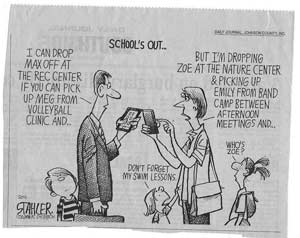 One of the things I love most about my job at High Trails is the opportunity to watch students really experience what it’s like to play in nature, and not just a structured game of Camouflage, but the chance to build things out of natural objects or throw rocks into the lake. Children need to be given space and time for play, especially in today’s society when so much of our daily lives are scheduled out.
One of the things I love most about my job at High Trails is the opportunity to watch students really experience what it’s like to play in nature, and not just a structured game of Camouflage, but the chance to build things out of natural objects or throw rocks into the lake. Children need to be given space and time for play, especially in today’s society when so much of our daily lives are scheduled out.
Most of my students wake up in the morning, go to school, attend specific after school activities, play sports, do homework, eat dinner, and then go to bed. Little time is left for free, imaginative playing, and frequently the free time that students do have they can be found playing video games or watching TV.

A minecraft forest.
I am continuously asking, how often do my students really get the chance to run around or play outside?
As an adult, I often forget how stimulating an experience can be when given the chance to explore freely. According to Eva Balke, World Organization for Early Childhood Education, “Children are born explorers and [they] take the material for play from the world in which they live.” 1 By allowing my students to experience the different offerings of the forest, I am hoping that they will realize the different forms of environment within our world, such as the micro-ecosystems of a river or within a fallen tree. In addition, I compare different habitats such as the desert to the one we are teaching in, the mountain forest.
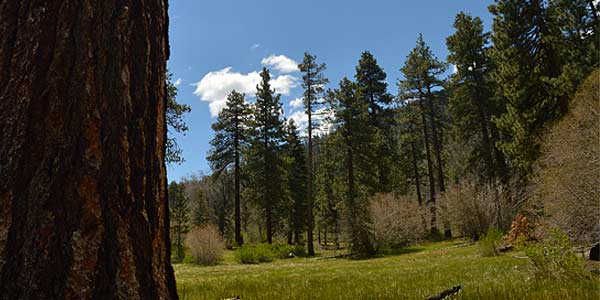
Our forest.
Some studies have shown that playing in “green” or “natural” spaces lead to more creative forms of play or positive attitudes towards nature. 2 I know that commonly when children do not have opportunities to explore natural environments they can develop a fear of the outdoors and its ecology. I see this through my students who have fears of sitting on the ground outside because of critters that roam the forest floor.
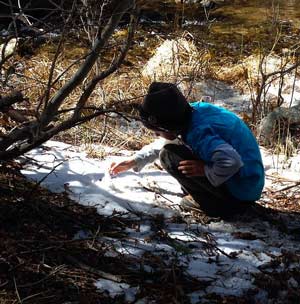 Other studies have directly linked adolescent behaviors to outdoor play. 3 Children and teenagers who experience playing in an outdoor environment regularly are often less aggressive, less accident prone, and have better focusing skills than those who watch TV and stay indoors. At High Trails, teachers frequently warn us about students who have problems focusing in school classrooms or getting along with others. Subsequently, those students are the ones who end up thriving in our program.
Other studies have directly linked adolescent behaviors to outdoor play. 3 Children and teenagers who experience playing in an outdoor environment regularly are often less aggressive, less accident prone, and have better focusing skills than those who watch TV and stay indoors. At High Trails, teachers frequently warn us about students who have problems focusing in school classrooms or getting along with others. Subsequently, those students are the ones who end up thriving in our program.
One of my favorite memories working at High Trails occurred in the fall when I was hiking with my class. I looked back and noticed that one boy who appeared to be “too cool for school” was holding the hand of the less popular student who was a little unstable. What I find that my students need most are the opportunities to explore themselves through natural obstacles and encounters.
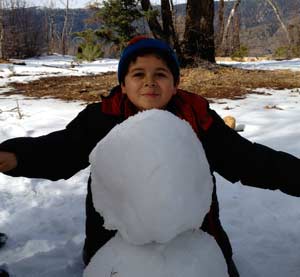 Many students do not get the opportunities to explore nature at home or with their families. Part of the reason is that parents are afraid to let their children play outside in a busy neighborhood unsupervised.
Many students do not get the opportunities to explore nature at home or with their families. Part of the reason is that parents are afraid to let their children play outside in a busy neighborhood unsupervised.
Other reasons have to do with busy schedules that accommodate birthday parties or sports games on the weekends.
Furthermore, there are many children in today’s society that just don’t have the chance to take vacations away from their neighborhood due to financial reasons.
Thinking about it, we might just be asking ourselves the wrong questions.
Instead of trying to figure out the benefits of playing, possibly we should be asking how could we inform parents or teachers of the importance for letting our children play outside and in unstructured environments? Other than the opportunity to spend one week in the forest at science camp, how do we provide students living in a concrete jungle with the chance to experience nature? For me, taking the classroom outside and placing emphasis on creating more green spaces within a city is a start, but I do believe more can be done.
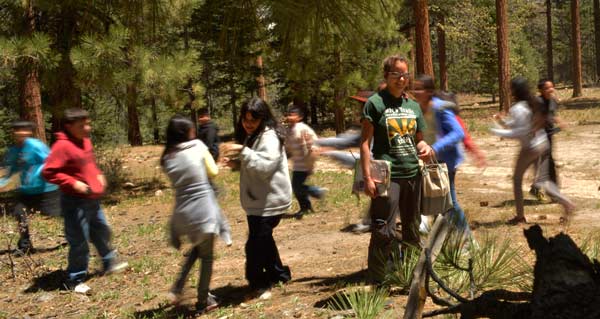
Allowing children to play freely in unaltered, natural spaces encourages creativity and a sense of wonder. As a field instructor, I habitually give my students time at lunch to roam around within my sight, explore and play. I can’t begin to tell you how many times that exploration has led to further questions and inquiry about our forest or other environments that the students are aware of. Allowing for students to explore nature within my classes both enriches the experiences of my students as well as my teaching practices and class content. It is an opportunity that I look forward to every time I take my students on a long hike.
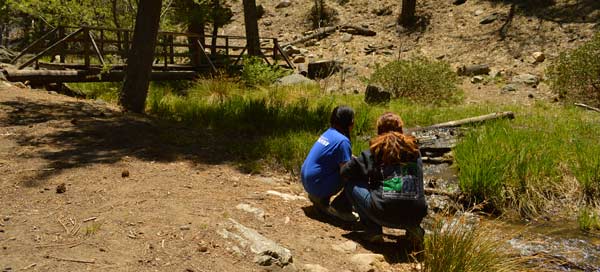
Parents, according to Ben Klasky, President and CEO of IslandWood, an innovative nonprofit organization that introduces thousands of low-income children to the outdoors each year, “You don’t need to be in a national park like Yosemite or the Grand Canyon to enjoy the benefits of the Great Outdoors. In fact, all you need to do to get outdoors is to simply take a step outside your door!” 4 Plant a tree, look for bugs, or let your children run through the grass with bare feet; it’s the simplest things that can create a spark, ignite their imagination, and stoke the embers of your child’s sense of wonder.
At High Trails Outdoor Science School, we literally force our instructors to write about elementary outdoor education, teaching outside, learning outside, our dirty classroom (the forest…gosh), environmental science, outdoor science, and all other tree hugging student and kid loving things that keep us engaged, passionate, driven, loving our job, digging our life, and spreading the word to anyone whose attention we can hold for long enough to actually make it through reading this entire sentence. Whew…. www.dirtyclassroom.com
- Balke, E. (1997). Play and the Arts: The Importance of the “Unimportant.” Childhood Education, 73(6), 355-360. ↩
- Louv, R. (2006). Last child in the woods: Saving our children from nature-deficit
disorder. Chapel Hill, NC: Algonquin Books of Chapel Hill; Wilson, R. (2008). Nature and young children: encouraging creative play and learning in natural environments. New York, NY: Routledge. ↩ - Louv, R. (2006). Last child in the woods: Saving our children from nature-deficit
disorder. Chapel Hill, NC: Algonquin Books of Chapel Hill; Wilson, R. (2008). Nature and young children: encouraging creative play and learning in natural environments. New York, NY: Routledge. ↩ - https://www.youtube.com/watch?v=ArhjLa4xbNk ↩

Comments are closed.